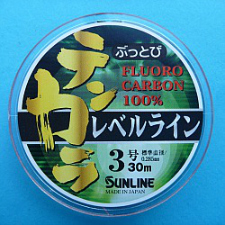Killer Bug
Frank Sawyer's Killer Bug is a great fly. Since I started tying this fly about 15 years ago it has been my most productive fly by far. What makes it even better is that it is very easy to tie and uses inexpensive materials (at least the way I tie it) just some knitting yarn, some copper wire and a Prismacolor marker.
The Grayling Killer Bug, as I believe it was originally called, was developed in the 1930s by Frank Sawyer, the same man who developed the pheasant tail nymph. At that time, Sawyer worked as a river keeper on the river Avon. As part of his duties, he was to rid the river of grayling. According to his grandson, Nick Sawyer, who runs Sawyer Nymphs in the UK, the fly that Frank developed (which imitates the gammarus pulex - what we call a scud) was more effective than netting or electro-fishing. I can believe it.
I often find myself wondering, "why do I fish anything else?" Variety, I guess. Nothing I've found outperforms it.
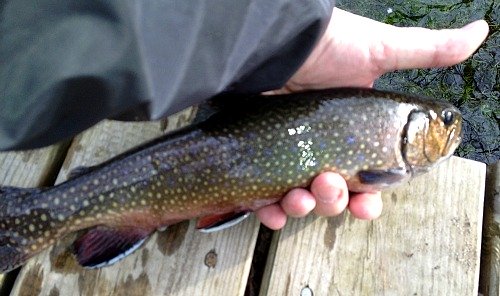 One of Terrence's first fish.
One of Terrence's first fish.I guess my comment above about inexpensive materials should be explained a bit, in that Sawyer tied his fly with a yarn that is no longer produced - Chadwick's 477. That yarn is now one of those almost unobtainable fly-tying materials that have achieve a near-mythical status - I would say more than polar bear hair or seal fur, more than the urine-stained fox fur for the Hendrickson (though maybe not more than the ram's scrotal hair that is, well, indispensable for the Tups Indispensable). Chadwick's 477 hasn't been produced for over 50 years now, and when the rare card is auctioned on eBay, it goes for over $100.
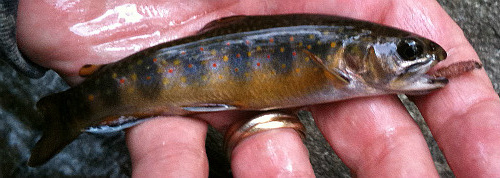 Wild brookies seem to like them, too.
Wild brookies seem to like them, too.Sawyer is quoted as having said, "The successful attraction of this pattern is due to the fact that the particular 'darning wool' used, completely changes colour when wet." Chadwick's 477 was a fawn color, kind of a greyish brown, but it had red fibers running through it. When the yarn was wet, the red fibers gave the yarn a pinkish tan hue.
Although substitutes are sold in the UK as Killer Bug Yarn, none that I have been able to find show the pinkish-tan color when wet.
I've also read comments on various forums that suggest that any yarn will work. I'm convinced the people who say that do so only because they haven't tried one that does turn a pinkish tan (just as the people who say tenkara is just dapping or cane pole fishing have never tried it.) I think Sawyer was absolutely correct when he said the successful attraction is due to the color.
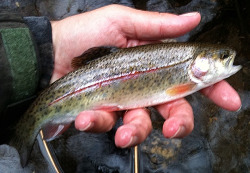 Killer Bugs aren't just for grayling. This stockie rainbow inhaled one.
Killer Bugs aren't just for grayling. This stockie rainbow inhaled one.I started fishing Killer Bugs in 2008. I looked extensively for a yarn that had the "fawn" color that Sawyer described, and also had red fibers running through it to give it the pinkish hue when wet. I found none.
The yarn I settled on then (and still use today) is Jamieson's Shetland Spindrift "Sand" yarn, which is an off-white, too light even to be called "oatmeal." But it does have the red fibers running through it. To give it the requisite tan color, I use an artist's Prismacolor marker. The color of the pen is also "Sand." Pure coincidence.
The resulting fly,
which turns a definite pinkish tan when wet, is a very close imitation
to the scuds that have a pinkish hue. I have finally gotten a very small
sample of the original Chadwicks 477, and the Sand marker I use is just
a little too tan but the trout don't seem to care. If they don't why
should I? It seems the Prismacolor Sand color, like the Chadwicks yarn, may have been discontinued. My marker is
still usable so I have not sought out a suitable replacement.
Look for a light tan, ideally with a slight grayish hue.
The fly is tied with copper wire instead of tying thread. The copper
wire provides a little bit of extra weight, but not nearly as much as a
lead underbody or even a beadhead. (With a soft rod and a light
line, you can still tell it's a weighted fly, though.) I believe Sawyer
used a varnished copper wire that had a slightly reddish brown color. The closest match I have found is called magnet wire, but I just use the copper wire sold by fly tying shops. As with the exact hue of the fawn/tan color, regarding whether the copper wire is varnished, the fish don't care.
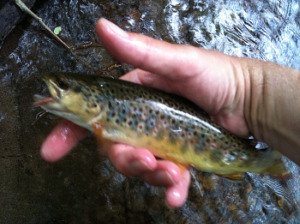 They're not just for stockie rainbows, either. This wild brown was fooled.
They're not just for stockie rainbows, either. This wild brown was fooled.Scuds can swim - fast - and for a time I fished the killer bug with quick tugs to mimic a scud's swimming action. Having fished with a truly Hi-Vis Fluorocarbon level line, and having seen strikes that I'm sure I wasn't seeing before, I now think a dead-drift approach may in fact be a better technique.
I don't know that giving action to the fly with quick tugs produces
more strikes, but it certainly causes your line to bounce around, and if
your line is bouncing around it is very hard to see the subtle strikes. Truly, some strikes are so subtle that they move the line much less than the motion caused by even a gentle pulsing action.
Also, when the line is bouncing, there are times that it is
slack, and a fish can spit out the fly long before you can take the
slack out of the line with your next tug.
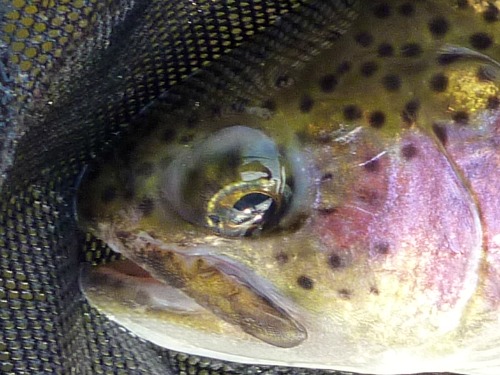
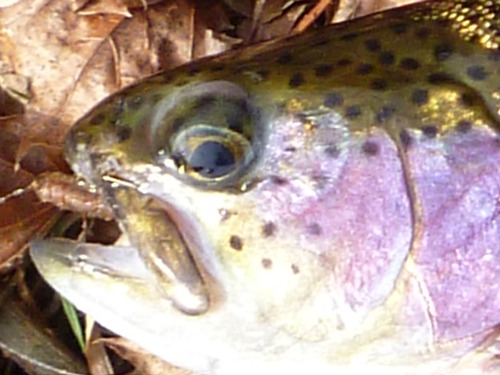 The two photos above show the same fish. Caught, released and caught again 14 minutes later with the same fly!
The two photos above show the same fish. Caught, released and caught again 14 minutes later with the same fly! Can your fly do that?
Killer Bug Step by Step
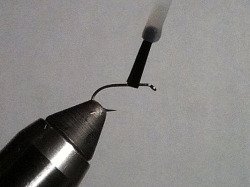
1. Because copper wire slips pretty easily when wrapped, I start by just touching the hook shank with super glue. I find the brush applicator works better. The red colored copper wire I use with the Utah Killer Bugs isn't as slick and with it I find the super glue is not necessary.
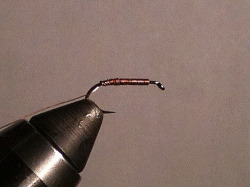
2. Start the copper wire at the eye, trapping it just like you would with tying thread. I wrap one layer from the eye to just before the bend. The photo shows the wire starting just behind the eye, but I now start it right at the eye.
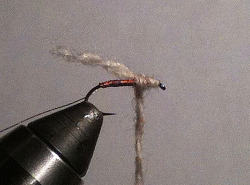
3. Start the yarn like you would start thread behind the hook eye. This photo was taken just before clipping off the tag end. Wrap to the bend, back to the eye and then back again to the bend. I try to untwist the yarn, which is two ply, so the the plies lay side by side as I am wrapping. You need to wrap tightly so the yarn doesn't start sliding around after a few fish. Some people twist the yarn more, so that it resembles a cord, which does produce a bit of a segmented look. I find the twisted yarn harder to control and have not noticed any improvement in catch rate.
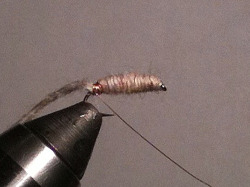
4. When you get to the bend, trap the yarn with one wrap of wire, then do a five turn whip finish with the wire (four turns if you are tying on a size 14 scud hook). Tighten the wire very gently and smoothly or it will break. When it is tightened, then break off the wire tag end. Clip the yarn tag end last.
I have always done a whip finish by hand rather than with a whip finish tool. For those who prefer to use a whip finish tool, I'll pass along a tip I received from Kirk A: use a whip finish tool designed for salmon flies, which sounds like it might be larger than the standard tool.
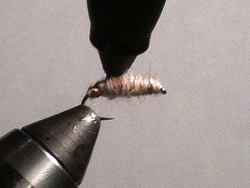
5. While the fly is still in the vise, color it thoroughly with the Sand Prismacolor marker*. It will look brown initially, but as the color sinks in, the fly will take on a pinkish tan look, which intensifies when the fly is wet. Coloring it roughly with the marker also raises loose fibers, which create a bit of a halo effect, and gives the impression legs.
*You may have to find a substitute because it is now very hard to find the Sand Prismacolor Art Markers. Alternatively, use Jamieson's Shetland Spindrift Oyster yarn instead of Sand, which will create a Utah Killer Bug. No marker needed.
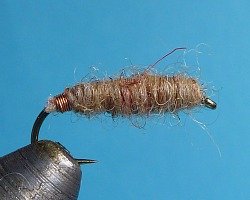 Killer Bug
Killer BugHook: Daiichi 1560 size 12
Wire: Ultra Wire, small, copper
Yarn: Jamieson's Shetland
Spindrift "Sand"
Marker: Prismacolor "Sand"
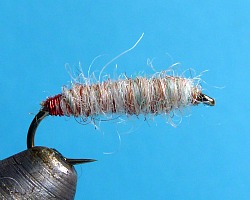 Utah Killer Bug
Utah Killer BugHook: Daiichi 1560 size 12
Wire: Ultra Wire, small, red
Yarn: Jamieson's Shetland
Spindrift "Oyster"
Marker: Not used
Utah Killer Bug
The Utah Killer Bug is an adaptation made by the Tenkara Guides in Salt Lake City, UT. In an attempt to simplify the tying process, they settled on a yarn that does not require the Prismacolor marker (Jamieson's Shetland Spindrift "Oyster"). I now call the yarn they chose Utah Killer Bug Yarn. It is darker and quite a bit pinker than the yarn I use for the Killer Bug. When wet, both yarns darken and both show a definite pinkish tan hue. Interestingly, the Prismacolor marker I use is not completely waterproof, so after a few uses, the yarn loses much of it's brown color and bugs tied with the two yarns end up looking pretty similar.
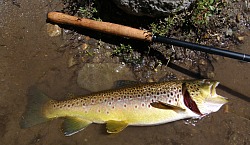 One of Bill H's Big Utah Killer Bug Browns
One of Bill H's Big Utah Killer Bug BrownsI do not tie the Utah Killer bugs quite like the Tenkara Guides do - although each of the Tenkara Guides ties it a bit differently. I tie them just the same way I tie the regular Killer Bugs.
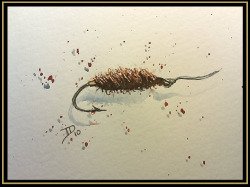 Sawyer's Killer Bug
Sawyer's Killer BugWatercolor by Joel DeJong
Another representation of Sawyer's Killer Bug is this watercolor by Joel
DeJong. Joel set out at the beginning of 2010 with the goal of painting
a different fly each day for the entire year and has documented his
progress in his blog A Year On The Fly. One of the flies he chose was Sawyer's Killer Bug.
TenkaraBum Home > Tenkara Flies > Killer Bug
“The bitterness of poor quality remains long after the sweetness of low price is forgotten” - Benjamin Franklin
"Be sure in casting, that your fly fall first into the water, for if the line fall first, it scares or frightens the fish..." -
Col. Robert Venables 1662
As age slows my pace, I will become more like the heron.
We've all had situations where seriously chewed up flies kept catching fish after fish after fish. It is no sin to tie flies that come off the vise looking seriously chewed up.
Warning:
The hooks are sharp.
The coffee's hot.
The fish are slippery when wet.
Beware of the Dogma
What's in stock?
Suntech Tenkarakyo 40F Tenkara Rods
Old Geezer's Wide-Eyed Fly Box
Coming Soon
December
Kurenai II AR 30F
Kurenai II AR 33F
Kurenai II AR 39F
Nissin Oni Line size 3
Nissin Oni Line size 3.5
TenkaraBum 33
TenkaraBum 36
TenkaraBum 40
Medium Rod Case
January
Furaibo TF39
Furaibo TF39TA
Latest Pages
Here's a pic of a 12" brookie I caught today on #14 killer bug. Caught two 14" rainbows as well. These were literally the first fish I ever caught! I just ordered more killer bugs to replace the three I lost to the trees.
Terrence R, New York
Thought I'd let you know that I had a chance to try my new rod, line and flies today - early season in Wisconsin opens the first Saturday in March. Despite the cold weather, I had a blast, and caught 27 trout in about 3 hours. 25 browns and 2 small brookies. I think it took about 3 casts to get my first fish The first 17 were caught on a Sawyer Killer Bug. Not a bad afternoon, especially with the water temp. being only 38.5 degrees. Suffice to say, I'm hooked.
Jacob B, Wisconsin
Hi Chris, Just a note for you and other Tenkara fisherman. Just got back from a backpack to the bottom of the Grand Canyon. Bring your Tenkara rod! No one fishes Bright Angel Creek. The killer bug caught fish at every stop. Fall flows are the best.
John W, California
Just got back from an epic tenkara trip in northern California and the Utah Killer Bug was DYNAMITE!!!!
Bill H, California
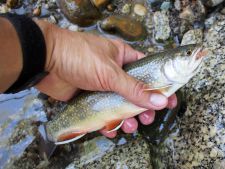
I just want to thank you for the great service. Awhile back I bought some Utah Killer Bug yarn and tied up some flies. At least out here in Utah, the fish can't resist them. I spent a day and a half up in the High Uintas Wilderness Area and caught 74 fish in about 4 hours, all on UKB's. I did try some traditional dry flies and the fish wouldn't touch them. Here is a photo from a local creek where I also had great success.
Matt C, Utah
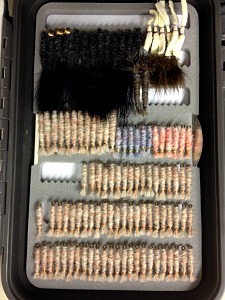
Your killer bug really is amazing. Here is a pic of one side of my fly box...hope you got a smile out of that. It's been fun.
Nelson H, Wisconsin
If you enjoy spin fishing or baitcasting please visit my sister site Finesse-Fishing.com.
Black Friday sale on now. 15% off on all Tenryu spinning and baitcasting rods.



